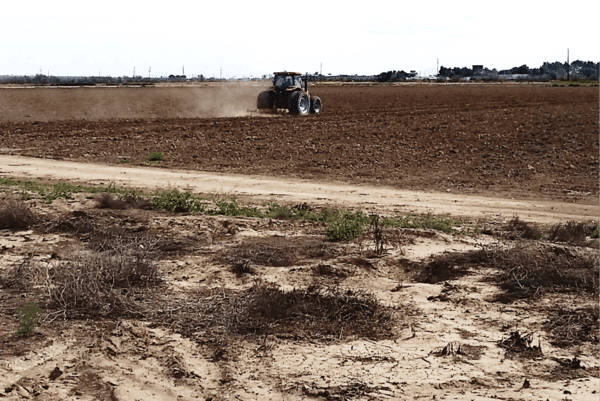
Photo: Tyler Lark
Clearing grasslands to make way for biofuels may seem counterproductive, but University of Wisconsin-Madison researchers show in a study today (April 2, 2015) that crops, including the corn and soy commonly used for biofuels, expanded onto 7 million acres of new land in the U.S. over a recent four-year period, replacing millions of acres of grasslands.
The study — from UW-Madison graduate student Tyler Lark, geography Professor Holly Gibbs, and postdoctoral researcher Meghan Salmon — is published in the journal Environmental Research Letters and addresses the debate over whether the recent boom in demand for common biofuel crops has led to the carbon-emitting conversion of natural areas. It also reveals loopholes in U.S. policies that may contribute to these unintended consequences.
“We realized there was remarkably limited information about how croplands have expanded across the United States in recent years,” says Lark, the lead author of the study. “Our results are surprising because they show large-scale conversion of new landscapes, which most people didn’t expect.”
The conversion to corn and soy alone, the researchers say, could have emitted as much carbon dioxide into the atmosphere as 34 coal-fired power plants operating for one year — the equivalent of 28 million more cars on the road.
The study is the first comprehensive analysis of land-use change across the U.S. between 2008 and 2012, in the “critical time period” following passage of the federal Renewable Fuel Standard (RFS), and during a “new era” of agriculture and biofuel demand, Lark and Gibbs say. The results may aid policymakers as Congress debates whether to reform or repeal parts of the RFS, which requires blending of gasoline with biofuels that are supposed to be grown only on pre-existing cropland, in order to minimize land-use change and its associated greenhouse gas emissions.
Lark recently visited Washington, D.C., to present the findings to the Environmental Protection Agency and the White House Office of Management and Budget, which share responsibility for rule-making and review of the RFS.
For instance, the study found that 3.5 million acres of corn and soy grown during this time period was produced on new, rather than pre-existing, cropland, rendering it potentially ineligible for renewable fuel production under the RFS. However, this went undetected due to limitations in current federal monitoring, which captures only national-level, aggregate land-use change rather than the high-resolution changes found in the study.
The study also showed that expanding the geographic scope of another policy, the Sodsaver provision of the 2014 Farm Bill, could better prevent widespread tilling of new soils. This policy reduces federal subsidies to farmers who grow on previously uncultivated land, but it applies in only six Northern Plains states. The researchers say the findings suggest a nationwide Sodsaver is needed to protect remaining native ecosystems, since roughly two-thirds of new cropland conversion occurred outside of these states.
Read more: Plowing prairies for grains: Biofuel crops replace grasslands nationwide
The Latest on: Biofuels and grasslands
[google_news title=”” keyword=”Biofuels and grasslands” num_posts=”10″ blurb_length=”0″ show_thumb=”left”]
via Google News
The Latest on: Biofuels and grasslands
- Vegetable oils and biodiversityon May 7, 2024 at 12:37 am
Oil crops occupy roughly 37% of the world’s agricultural land, and oil demand is growing. By 2050, expected demand for vegetable oils could require a 14% increase in production – potentially ...
- How policy can drive market for biofuelson May 7, 2024 at 12:01 am
Federal policy on biofuels can make or break U.S. grain markets, so farmers need to keep a watchful eye on Washington, D.C.
- Biden OKs tax credits so corn can be jet fuel ingredient, but farmers wary of requirementson May 5, 2024 at 8:59 pm
To qualify, farmers would have to do three things on the land where they grow the corn: plant cover crops, avoid tilling the soil and use "enhanced efficiency" nitrogen fertilizers.
- Biden opens door for tax credits so corn farmers can grow jet fuelon May 2, 2024 at 3:22 pm
To cut greenhouse gas emissions from airplanes, the Biden administration issued guidelines this week that could shape U.S. farming for decades by offering corn growers tax credits to turn their crop ...
- Making Flying Cleaneron May 2, 2024 at 3:14 pm
New guidelines attempt to make the aviation cleaner by relying on corn-based ethanol, but experts divided on the fuel’s environmental benefits.
- Four Modes Of Agricultural Value Creation In The Carbon Ageon July 27, 2023 at 7:00 am
This is a normal process that goes on in any forest, grassland, or other undisturbed ... transportation sector is to power vehicles with biofuels, but the climate benefit of that approach depends ...
- The Next Breadbasketon August 13, 2020 at 6:49 am
Since 2004 some six million acres have been leased to both foreign and domestic investors for everything from forestry products to biofuels to ... Brazil’s cerrado grasslands into one of the ...
- Caution urged over biofuelson March 23, 2008 at 5:00 pm
Abigail Bunker, agriculture policy officer of the RSPB, said: "Biofuels threaten untold damage to unique wildlife habitats across the world. "Their production is already causing the destruction of ...
via Bing News










